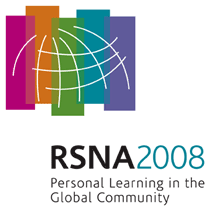
Abstract Archives of the RSNA, 2008
Luis Salgueiro Guimaraes MD, Presenter: Nothing to Disclose
Lifeng Yu PhD, Abstract Co-Author: Research grant, Xoran Technologies, Inc
Armando Manduca PhD, Abstract Co-Author: Nothing to Disclose
Natalia Khaylova PhD, Abstract Co-Author: Nothing to Disclose
James E. Huprich MD, Abstract Co-Author: Nothing to Disclose
Jeff Lynn Fidler MD, Abstract Co-Author: Grant, E-Z-EM, Inc, Lake Success, NY
Joel Garland Fletcher MD, Abstract Co-Author: Research grant, Siemens AG
Grant, E-Z-EM, Inc
License agreement, General Electric Company
et al, Abstract Co-Author: Nothing to Disclose
Dual energy CT enterography (CTE) distributes power equally to two x-ray tubes, one utilizing 80 kV and the other 120 or140 kV. Using a dual energy CTE protocol, we utilized the CT signal of the 80 kV tube only (i.e., < 50% of the total dose), to examine recently developed novel denoising methods (in image or projection space). Our purpose was to determine if denoising methods can reduce dose and/or improve image quality.
A projection-space denoising technique for noise reduction in CT was developed, which is based upon bilateral filtering and incorporates a CT noise model considering the effect of bowtie filters and automatic exposure control. 12 patients underwent dual-energy CTE (Definition DS, Siemens Medical) with one x-ray tube operating at 140 kV and the other at 80 kV. The dose ratio was 1.3:1 (combined CTDIvol ~14 mGy). Only the 80 kV raw CT datasets were denoised using the developed technique at four different levels. The 80 kV signal was also reconstructed using two commercial kernels (B25 and B40) and two image-space 3D adaptive denoising methods (Siemens Medical), for a total of 8 reconstructed datasets per patient. Two radiologists (blinded to reconstruction methods) ranked image quality of 1 mm slices from best to worst. Using a 5 point scale the image quality of the best reconstructed 80 kV dataset (using < 50% of the dose) and the mixed kV dataset (utilizing full dose and output from both tubes) were rated, with a final preference given comparing these two datasets (80 kV, mixed kV or equal).
The novel projection space denoising methods resulted in the best image quality in 10/12 cases, while the 3D adaptive denoising methods were best in 2/12, with the standard commercial kernels resulting in the worst quality in all cases. Mean image quality score for best denoised 80 kV reconstruction was 4.2, compared to 4.3 for the full dose mixed kV datasets. In 9/12 (75%) of cases, the denoised dataset was equally (n=8) or mostly (n=1) preferred.
Denoising methods can dramatically reduce dose and improve image quality compared to standard reconstruction kernels at 80 kV CTE. The best 80 kV denoising method resulted in at least equal image quality to full dose scans in 75% of cases, but required < 50% of the dose.
Denoising methods in projection and image space can result in dramatic reductions in radiation dose and improvement in image quality.
Guimaraes, L,
Yu, L,
Manduca, A,
Khaylova, N,
Huprich, J,
Fidler, J,
Fletcher, J,
et al, ,
Pilot Study Demonstrating Dramatic Dose Reduction Using Novel Denoising Techniques for 80 kV CT Enterography. Radiological Society of North America 2008 Scientific Assembly and Annual Meeting, February 18 - February 20, 2008 ,Chicago IL.
http://archive.rsna.org/2008/6010764.html

